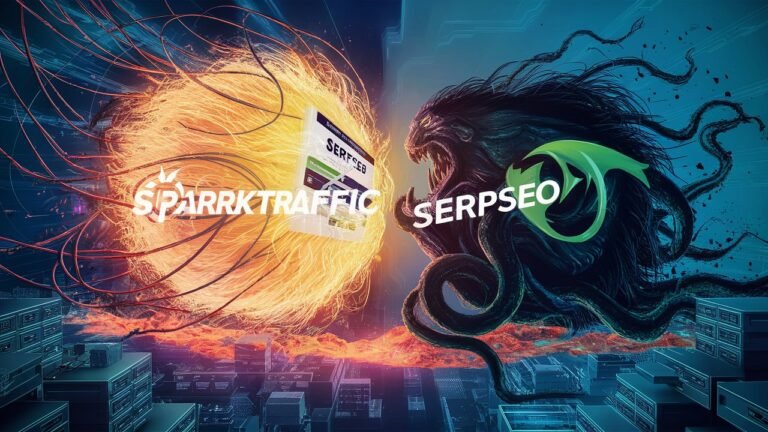In today’s competitive digital landscape, driving website traffic and optimizing for search engines are critical for online visibility. Two tools that claim to address these needs are SparkTraffic and SERPSEO. While both aim to enhance your website’s performance, they cater to different aspects of digital marketing. SparkTraffic focuses on traffic generation, whereas sparktraffic vs serpseo emphasizes SEO optimization and organic growth. This article dives deep into their features, strengths, and limitations, helping you decide which tool aligns with your goals. Whether you prioritize quick traffic boosts or long-term SEO strategies, this comparison will clarify the best path forward.
Understanding SparkTraffic and SERPSEO: Core Features and Differences
Sparktraffic vs serpseo is a traffic generation tool designed to increase website visitors through automated or semi-automated methods. It emphasizes volume, offering packages that deliver thousands of visits to your site quickly. This tool is ideal for users seeking immediate results for metrics like ad revenue or social proof. However, it lacks built-in SEO tools, making it a short-term solution.
SERPSEO, on the other hand, is an all-in-one SEO platform. It focuses on improving search engine rankings through keyword research, backlink analysis, competitor tracking, and on-page optimization. Unlike SparkTraffic, SERPSEO prioritizes sustainable growth by aligning with search engine algorithms. Its comprehensive dashboard provides actionable insights for long-term organic traffic gains.
Key Difference: SparkTraffic delivers rapid traffic spikes, while SERPSEO builds lasting visibility through SEO.
Traffic Generation: SparkTraffic’s Approach vs. SERPSEO’s Strategy
Sparktraffic vs serpseo primary selling point is its ability to generate high volumes of traffic quickly. Users can select geo-targeted visits, customize duration, and even choose traffic sources (e.g., direct, referral, or social). However, critics argue that this traffic may lack engagement, as it often comes from bots or incentivized users. This can lead to high bounce rates and minimal conversions, making it risky for businesses focused on ROI.
SERPSEO takes a different route. Instead of sending traffic directly, it enhances organic reach by optimizing your site for search engines. By identifying high-value keywords, improving content quality, and building authoritative backlinks, SERPSEO helps your site rank higher on Google. This strategy attracts genuine users actively searching for your offerings, resulting in higher engagement and conversion potential.
SEO Optimization: How SERPSEO Enhances Search Engine Rankings
SERPSEO’s toolkit is built for SEO success. Its keyword research module identifies low-competition, high-traffic keywords, while the rank tracker monitors your progress daily. The platform also offers on-page SEO recommendations, such as meta tag optimization, content readability scores, and internal linking strategies.
Additionally, SERPSEO’s backlink analyzer audits your link profile, highlighting toxic links and suggesting reputable sources for new backlinks. These features ensure your site adheres to search engine guidelines, reducing penalties and improving trustworthiness.
SparkTraffic lacks these capabilities entirely. While it can inflate visitor numbers, it does nothing to address technical SEO, content quality, or backlink health—factors critical for sustainable growth.
User Experience and Interface: Navigating SparkTraffic and SERPSEO
SparkTraffic’s interface is simple and minimalist, suited for beginners. Users select a traffic package, enter their URL, and let the tool handle the rest. However, its lack of analytics or customization options may frustrate advanced users seeking detailed insights.
SERPSEO offers a robust, data-rich dashboard with granular control over SEO campaigns. While its learning curve is steeper, the platform provides tutorials, webinars, and tooltips to guide users. Features like drag-and-drop report builders and customizable dashboards cater to marketers who value depth over simplicity.
Pricing Models: Comparing Costs and Value for Money
Sparktraffic vs serpseo uses a volume-based pricing model, with packages ranging from 10for1,000visitsto400 for 100,000 visits. While affordable, the value is questionable if the traffic doesn’t convert.
SERPSEO adopts a subscription model, starting at 49/monthforbasicSEOtoolsandscalingto299/month for advanced features like competitor analysis and API access. Though pricier, it delivers measurable ROI through improved rankings and organic traffic.
Customer Support and Resources: Which Platform Offers Better Assistance?
SparkTraffic provides limited support, primarily via email. Its knowledge base is sparse, leaving users to troubleshoot issues independently.
SERPSEO excels here, offering 24/7 live chat, email support, and an extensive library of guides and video tutorials. Regular webinars and a community forum further enhance its support ecosystem.
Pros and Cons: Weighing the Strengths and Weaknesses
SparkTraffic Pros:
- Fast traffic delivery
- Budget-friendly for short-term needs
- Easy to use
SparkTraffic Cons:
- Low-quality traffic risks
- No SEO tools
- Minimal analytics
SERPSEO Pros:
- Comprehensive SEO tools
- Sustainable organic growth
- Detailed analytics and reporting
SERPSEO Cons:
- Steeper learning curve
- Higher cost
- No direct traffic generation
Conclusion
Choosing between Sparktraffic vs Serpseo hinges on your goals. If you need immediate traffic for temporary campaigns, SparkTraffic suffices. However, for long-term growth and SEO health, SERPSEO is the clear winner. Invest in SERPSEO to build a resilient online presence, or use SparkTraffic cautiously for short-term metrics. Ultimately, combining both (if budget allows) could balance quick wins with sustainable strategy.
Frequently Asked Questions (FAQs)
Q1: Which tool is better for small businesses?
A: SERPSEO is ideal for small businesses aiming to grow organically. SparkTraffic’s traffic may not convert well for niche markets.
Q2: Can these tools integrate with Google Analytics?
A: SERPSEO supports integration with Google Analytics and Search Console. SparkTraffic does not offer integrations.
Q3: Is SparkTraffic effective for improving SEO?
A: No. SparkTraffic doesn’t provide SEO tools or organic traffic, which are essential for rankings.
Q4: Do either platforms offer free trials?
A: SERPSEO offers a 7-day free trial. SparkTraffic has no trial but provides a money-back guarantee.
Q5: How quickly does SERPSEO improve search rankings?
A: Results vary, but most users see improvements within 3–6 months with consistent optimization.
